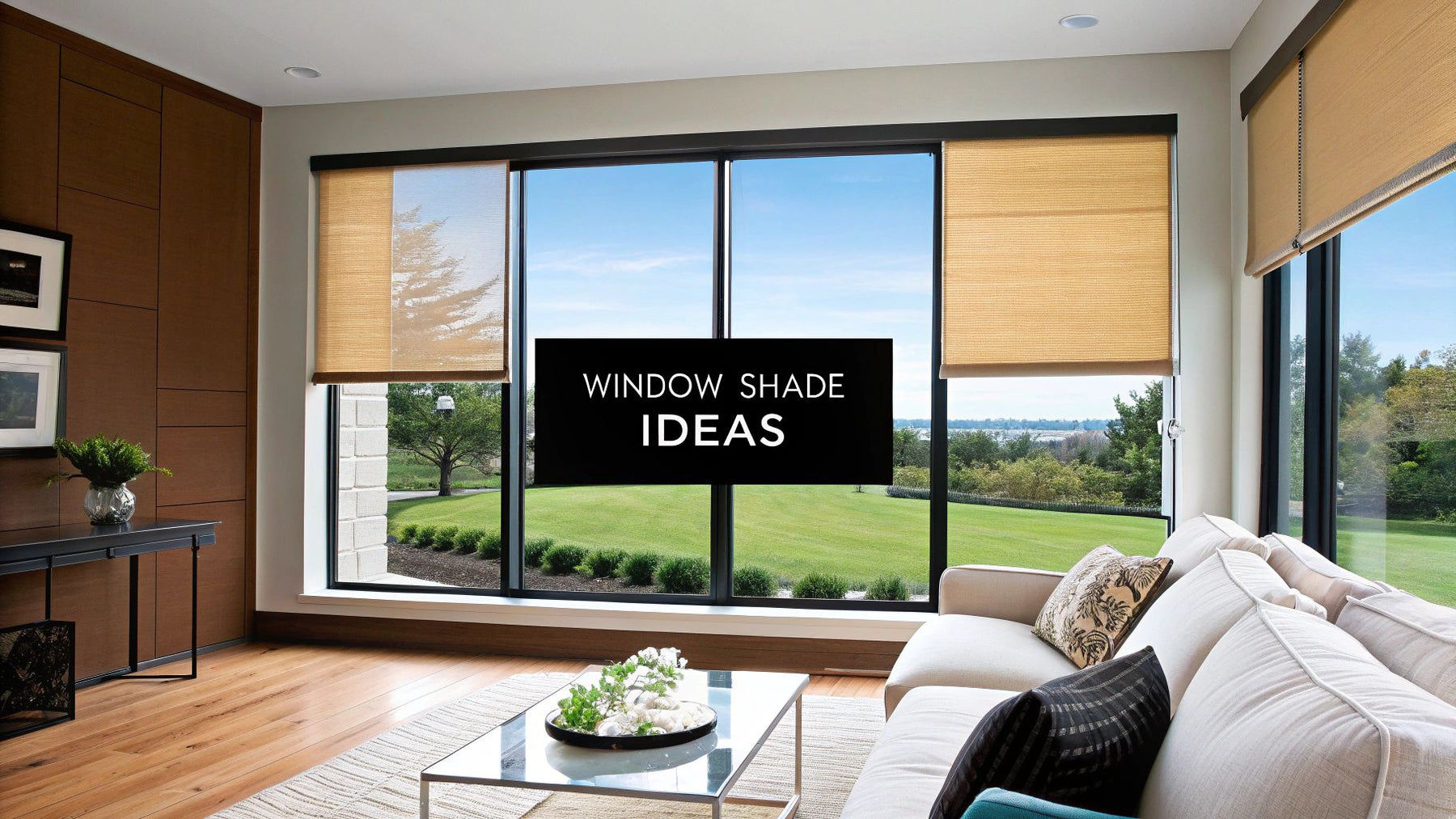
12 Inspiring Large Window Shade Ideas for Your Home
When exploring large window shade ideas, the goal is to find the perfect balance between style, light control, and functionality. The best options, such as Roller, Solar, Cellular, and Roman shades, each offer unique benefits, from blocking harsh UV rays to improving your home's insulation. The right choice can perfectly complement any room's decor and meet your practical needs.
This guide provides expert insights into choosing the best shades for your oversized windows, ensuring they become a stunning feature, not a design challenge.
Table of Contents
- Why Your Grand Windows Deserve the Right Shades
- Matching the Right Shade Style to Your Room
- How Fabric Choices Elevate Your Window Treatments
- Upgrading Your Home with Smart Motorized Shades
- Boosting Home Health and Energy Efficiency
- How to Correctly Measure for Large Window Shades
- Frequently Asked Questions
Why Your Grand Windows Deserve the Right Shades
Large windows are architectural showstoppers. They fill your home with natural light and offer expansive views. However, they can also introduce challenges like excessive heat, blinding glare, and a lack of privacy. Selecting the right window treatment is a strategic decision that directly impacts your home’s comfort and energy efficiency.
The ideal shade acts as a sophisticated filter for your home. Think of it like a premium pair of sunglasses: it protects you from harsh UV rays and annoying glare while preserving your view. In the same way, the right shades can tame intense afternoon sun without forcing you to hide your beautiful windows.
Beyond Aesthetics: What to Prioritize
While it's easy to focus on colors and patterns, the true value of a window treatment lies in its daily performance. A shade might look beautiful, but if it's difficult to operate on a tall window, it quickly becomes a frustration rather than a feature.
Here are the three primary factors to consider:
- Light Control: What is your main objective? Do you need to gently diffuse light, achieve complete darkness for a home theater, or simply reduce glare on a screen? Each scenario requires a specific type of shade and fabric.
- Energy Efficiency: Large panes of glass are a major source of heat transfer, leading to heat loss in winter and heat gain in summer. A high-quality insulating shade can make a significant impact on your utility bills.
- Ease of Operation: Manually lifting a shade that is 10 feet wide is a significant effort. For extra-large or hard-to-reach windows, motorization is a game-changing upgrade that adds convenience and a modern touch.
This visual summary highlights the key benefits that modern shades bring to expansive windows.
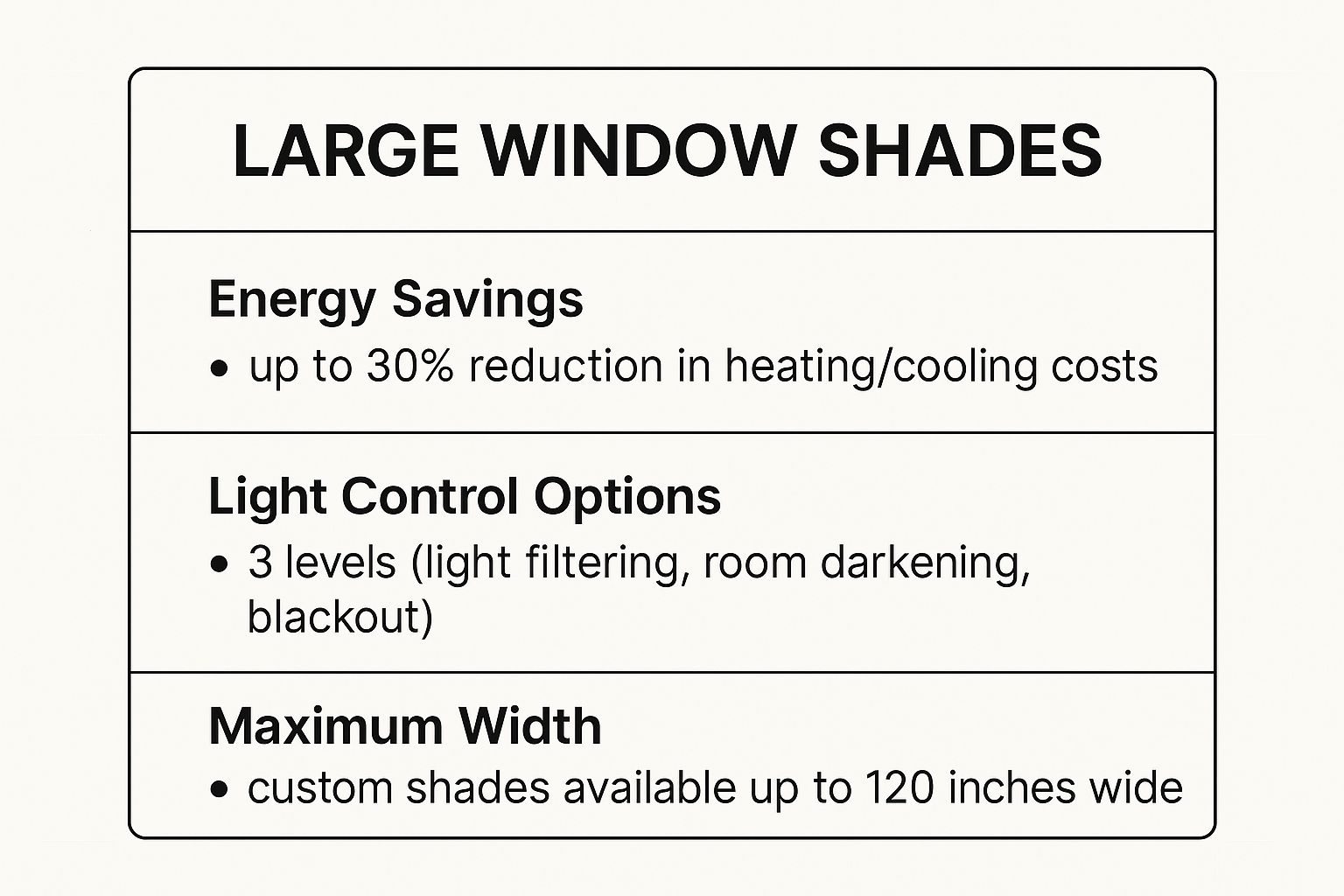
As you can see, the right shades can reduce energy costs by up to 30% and are available in custom widths to fit even the most massive windows.
Quick Guide to Large Window Shade Styles
To help you narrow down the options, here is a quick comparison of the most popular shade styles for large windows. This table outlines what each style does best, so you can find the perfect match for your space.
| Shade Type | Best For | Light Control | Insulation | Style |
|---|---|---|---|---|
| Roller Shades | A clean, minimalist look and unobstructed views. | Excellent | Low | Modern, Simple |
| Solar Shades | Reducing glare and UV rays while preserving the view. | Good | Low | Sleek, Functional |
| Cellular Shades | Maximum energy efficiency and insulation. | Excellent | High | Versatile, Classic |
| Roman Shades | Adding a soft, elegant, and decorative touch. | Good | Moderate | Timeless, Luxurious |
Each of these options offers a different combination of benefits. Cellular shades are the superstars of insulation, while solar shades are all about protecting your interiors from the sun without losing your connection to the outdoors. It all comes back to what you need your shades to do.
The goal is to find a solution that not only complements your decor but also works for your lifestyle. A well-chosen shade enhances the beauty of your windows while solving practical issues like privacy and energy loss.
While shades are fantastic on their own, don't forget you can always layer them. If you're looking for more inspiration on how to combine treatments, take a look at our guide on curtain ideas for big windows to craft a look that's truly all your own.
Matching the Right Shade Style to Your Room
Choosing the right shade is about solving a specific problem. Think of it like selecting the right tool for a job—you wouldn't use a delicate, light-filtering shade in a media room that requires total darkness.
Let's break down the best large window shade ideas for different spaces in your home, one room at a time.
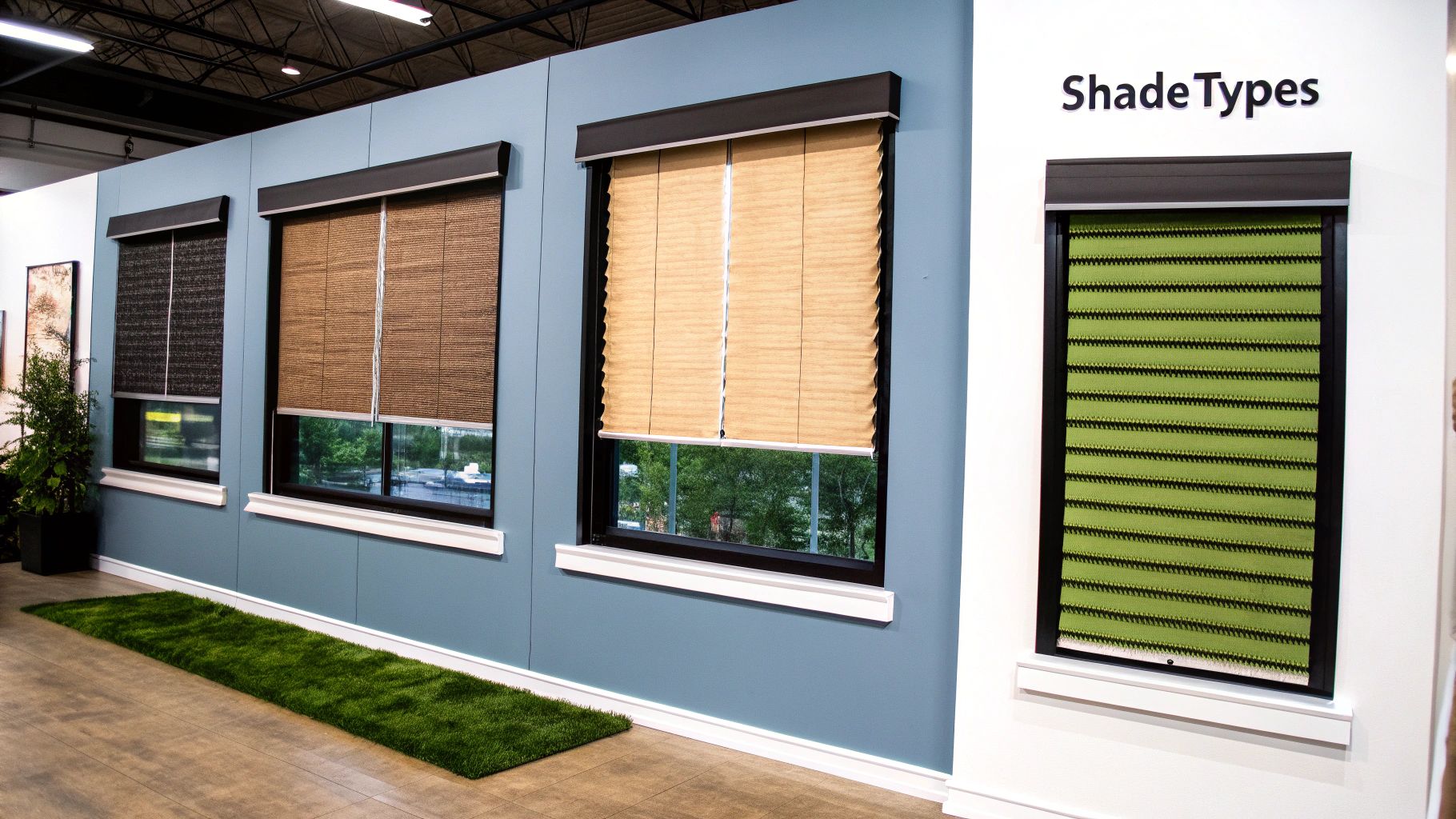
The goal is to match the function of the shade to the function of the room. We'll examine the top contenders—Roller, Solar, Cellular, and Roman shades—to see how they perform in real-world applications. This will help you turn your oversized windows from a design challenge into your home's most stunning feature.
Solar Shades for Sun-Drenched Living Rooms and Sunrooms
If your living room or sunroom receives intense afternoon sun, you know the struggle: glare makes it impossible to watch TV, the heat becomes uncomfortable, and your furniture is at risk of fading. Solar shades are the ideal solution for this common problem.
Think of them as high-tech sunglasses for your home. They are specifically engineered with an open-weave fabric that cuts glare and blocks up to 99% of damaging UV rays, all while preserving your beautiful view.
- Pros: They excel at reducing glare and heat, protecting interiors from sun damage, and maintaining an outdoor view. Their minimalist design complements modern decor perfectly.
- Cons: Solar shades do not provide significant privacy, especially at night when interior lights are on. If your living room faces a busy street, consider layering them with curtains for evening privacy.
For anyone trying to balance enjoying natural light with maintaining comfort, solar shades are an incredibly smart and functional solution.
Cellular Shades for Bedrooms and Nurseries
When it comes to bedrooms, two factors are paramount: privacy and darkness. A good night's sleep often depends on creating a dark, serene sanctuary, and cellular shades (also known as honeycomb shades) are the undisputed champions for this task.
Their secret is their unique construction, which features honeycomb-shaped pockets that trap air. This design creates a powerful insulating barrier that not only blocks light with incredible efficiency but also helps regulate room temperature and dampen outside noise.
The magic is in the cellular structure. This design provides some of the best insulation available in a window treatment, helping to keep rooms warmer in the winter and cooler in the summer.
For a bedroom, this translates to better sleep and lower energy bills. Cellular shades are available in a range of opacities, from light-filtering to total blackout, making them highly versatile. For more tailored advice, our guide on how to choose window treatments can offer deeper insights.
Roller Shades for a Clean and Modern Aesthetic
Roller shades are the chameleons of the window treatment world. Their beauty lies in their simplicity: a single, clean panel of fabric that rolls up neatly, leaving a completely unobstructed view. This makes them one of the most popular large window shade ideas for homes with minimalist or contemporary designs.
Because the design is so simple, the fabric choice does all the talking. You can find them in everything from sheer, light-diffusing materials that create a soft glow to heavy-duty blackout fabrics for total light control.
- Best for: Kitchens, home offices, and any room where you want a crisp, uncluttered look.
- Why they work: They are incredibly easy to operate, especially with motorization. Their slim profile ensures they never feel bulky, even on the largest windows.
The sheer variety of fabrics available means you can customize a roller shade to solve almost any light-control problem while maintaining a sleek, modern aesthetic.
Roman Shades for an Elegant and Soft Touch
If you love the softness of drapes but need the clean functionality of a shade, Roman shades offer the perfect compromise. They are constructed from a single piece of fabric that folds into soft, horizontal pleats when raised, creating a beautifully layered look that adds texture and warmth.
Roman shades are ideal for more formal spaces like a dining room or a primary bedroom where you want to create a luxurious, tailored feel. They bring a level of elegance that other shades cannot quite match.
While they look stunning, keep in mind that the stacked fabric at the top will block a small portion of your view even when fully open. For most homeowners who prioritize style and a cozy atmosphere, this small trade-off is well worth it.
How Fabric Choices Elevate Your Window Treatments
Once you’ve selected a shade style, the next crucial decision is the fabric. This choice goes beyond color; the material is the engine that drives your shade's performance, defining everything from the room's ambiance to its energy efficiency.
Think of fabric as a dimmer switch for the sun. Your choice directly controls how much light enters a room and what that light feels like. Getting this detail right is what transforms a good window treatment into a great one.
The Three Tiers of Light Control
For large windows, managing sunlight is the primary function. Fabrics generally fall into three main categories of opacity, each designed for a different purpose.
- Light-Filtering Fabrics: These are masters of ambiance. They gently diffuse harsh sunlight, cutting glare while casting a warm, inviting glow. They are perfect for living rooms and kitchens where you want bright, usable light without feeling like you're in a spotlight.
- Room-Darkening Fabrics: This is a significant step up in light control. These materials block a substantial amount of light, making them an excellent fit for home offices or TV rooms where reducing screen glare is essential. You’ll get significant privacy, day or night.
- Blackout Fabrics: For rooms that demand total darkness, blackout is the only solution. Made with a special opaque lining, these fabrics block 99% of incoming light. They are the champion for bedrooms, nurseries, and media rooms, creating a pitch-black environment perfect for sleep or movie nights.
Choosing between these isn't just a design choice; it's a lifestyle one. A light-filtering fabric in a home theater would be a constant frustration, just as a blackout shade in a bright sunroom would completely defeat the purpose of the space. Always start by thinking about how you actually use the room.
Material Composition Matters
Beyond light control, the fabric's composition impacts its durability, texture, and overall aesthetic. You wouldn't put delicate silk in a busy kitchen, and the same logic applies to shades.
The texture alone can add incredible depth. For example, understanding the differences between various fabric types like velvet can help you visualize how a material will hang and interact with light. Some materials lend a sleek, modern finish, while others create a soft, traditional atmosphere.
For instance, durable vinyls and solar screen fabrics are easy to clean and resist moisture, making them a practical choice for kitchens and bathrooms. In contrast, woven textures and natural fibers like linen add warmth and elegance, perfect for a formal dining room or a cozy bedroom.
Balancing Style with Long-Term Value
Investing in high-quality window treatments is a smart decision. According to Research Nester, the global market for curtains and blinds is projected to reach USD 44.58 billion by 2035, driven by homeowner demand for energy efficiency, smart features, and lasting style.
Choosing the right fabric is a huge part of that investment. A high-quality, durable material will not only look better initially but will also withstand years of sun exposure without fading or deteriorating.
Upgrading Your Home with Smart Motorized Shades
Let's be honest: operating shades on tall, wide, or hard-to-reach windows can be a daily chore. Motorization is the modern solution that replaces this hassle with convenience, safety, and a touch of luxury. It’s one of the smartest large window shade ideas for a good reason.
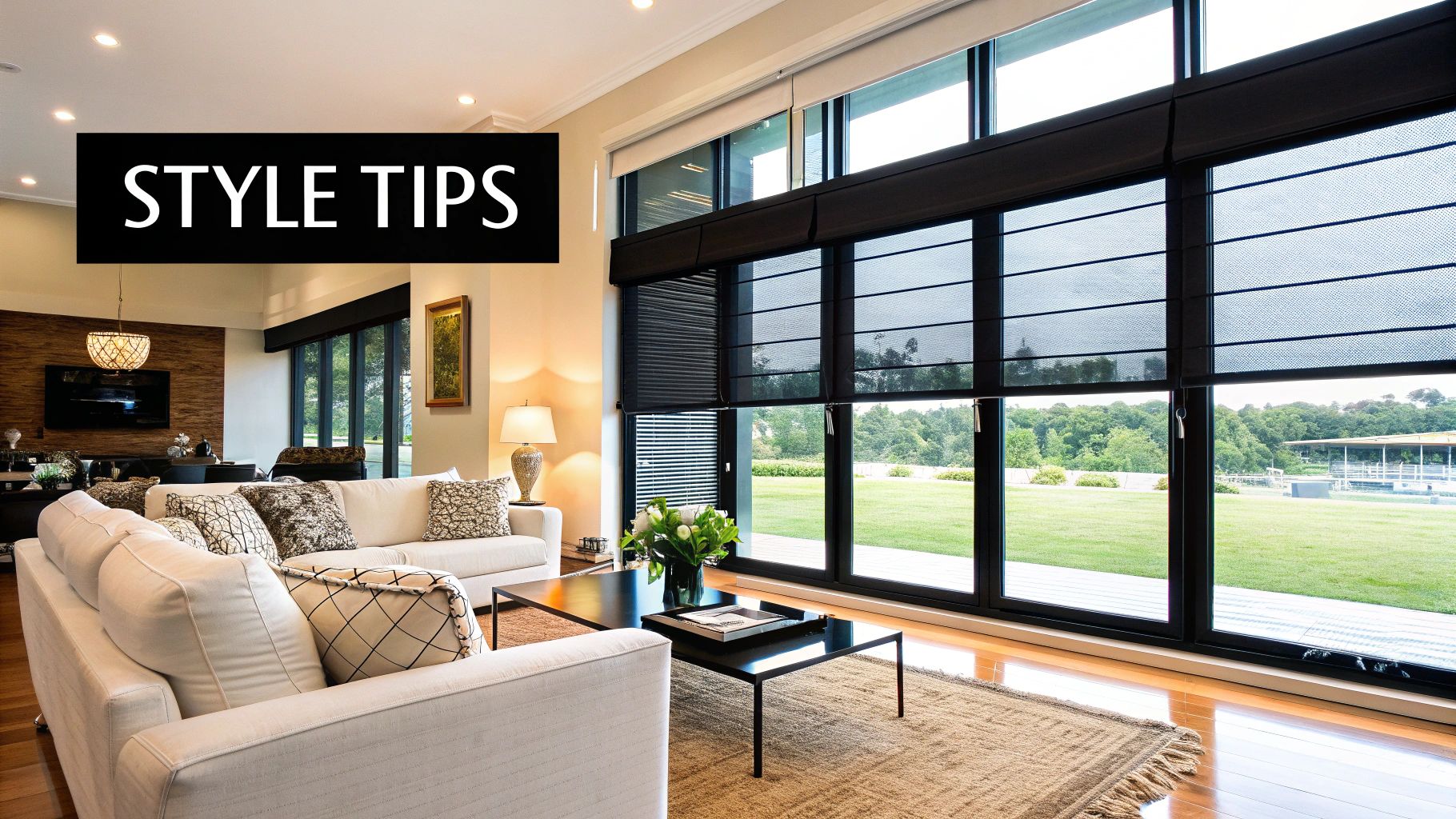
This is more than a cool gadget; it’s a practical upgrade that transforms how you interact with your space, giving you control over every shade with a single click.
More Than Just a Remote Control
The real magic happens with smart home integration. By connecting your shades to a system like Amazon Alexa, Google Home, or Apple HomeKit, you unlock a new level of automated living.
Imagine your shades automatically closing during the hottest part of the afternoon to keep your home cool. Or picture them opening gently with your morning alarm to let in natural light. This isn't a futuristic fantasy; it's a simple, achievable upgrade.
The biggest benefit is automating your home’s response to the environment. It reduces energy consumption by blocking solar heat gain in summer and helps protect your valuable furniture, art, and flooring from long-term UV damage.
This kind of smart automation is a significant market driver. Homeowners are increasingly seeking functional, tech-savvy solutions like our Joey’z Shopping smart shades.
Key Benefits of Motorized Shades
Switching to motorized shades offers powerful advantages beyond convenience. Here’s why this upgrade is a smart investment:
- Enhanced Safety: Motorized shades eliminate dangling cords, making them an inherently safer choice for homes with children or pets.
- Effortless Operation: For massive picture windows or those in vaulted ceilings, manual operation is often impractical. Motorization makes adjustments as easy as changing a TV channel.
- Increased Home Value: Smart home features are a major draw for modern homebuyers. Automated shades are a functional upgrade that can add genuine appeal and value.
- Energy Savings: Scheduling shades to close during peak sun hours significantly reduces the strain on your air conditioning, leading to lower energy bills over time.
Choosing the Right Motorization Option
You generally have three main power source options for motorized shades. The best one depends on your home's setup and budget.
Power Source Comparison
| Power Source | Best For | Pros | Cons |
|---|---|---|---|
| Battery-Powered | Easy retrofitting and DIY projects | Simple installation, no wiring needed | Batteries need recharging/replacing (every 1-2 years) |
| Hardwired | New construction or major renovations | Highly reliable, no batteries to worry about | Requires professional installation by an electrician |
| Plug-In | Windows near an existing electrical outlet | Consistent power, no batteries | Visible cord can detract from the clean look |
For most homeowners adding motorization to existing windows, a rechargeable battery system offers the perfect blend of performance and simplicity, providing all the benefits of automation without the expense of opening up walls.
Boosting Home Health and Energy Efficiency
The best large window shade ideas do more than look good; they help create a healthier, more comfortable, and energy-efficient home. Choosing the right shade is an investment in your well-being, impacting everything from your sleep quality to your monthly utility bills.
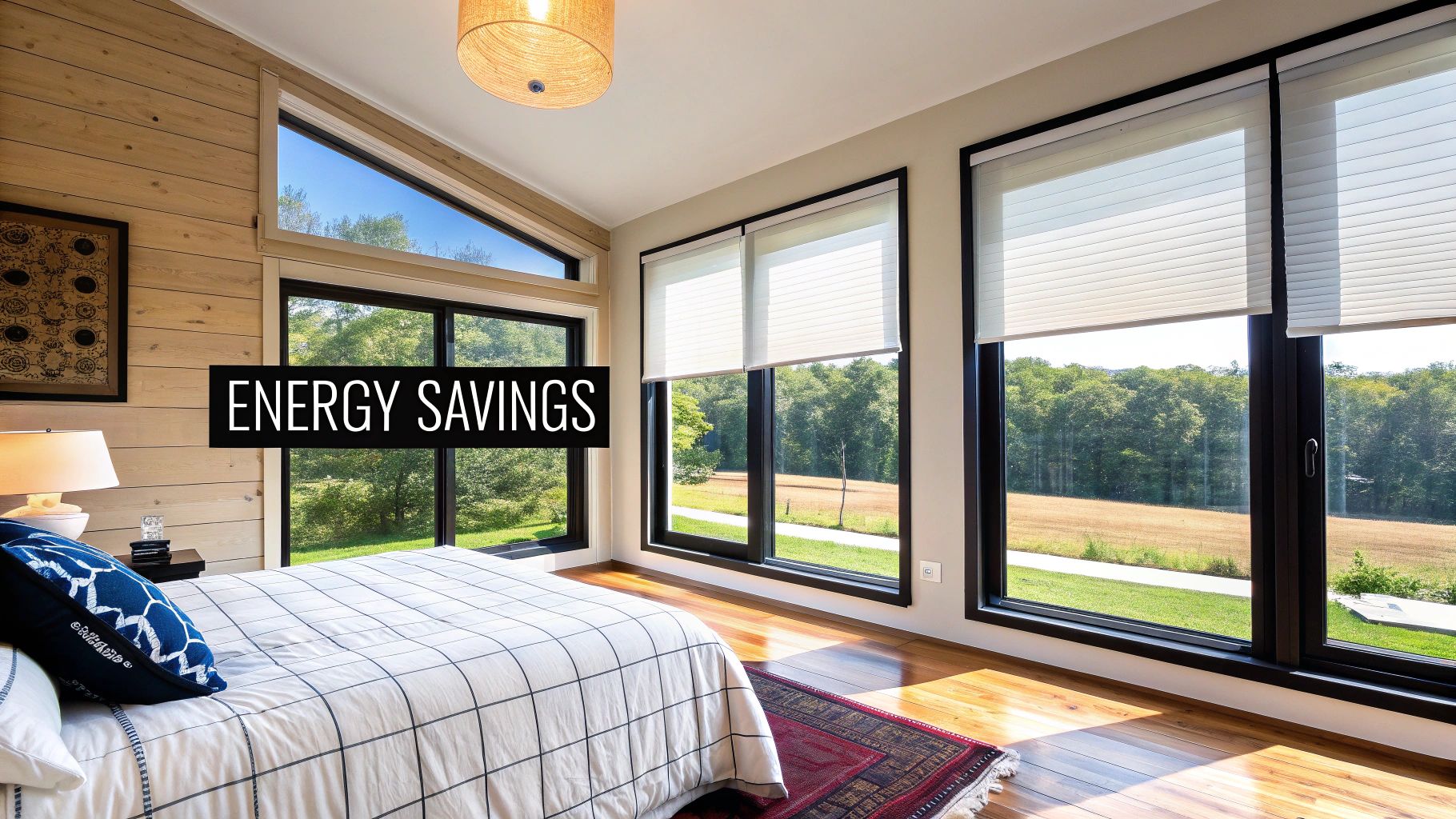
This trend toward functional window treatments is growing. According to Fortune Business Insights, the global blinds and shades market is expanding as consumers demand features that improve their home environment. The rising popularity of blackout shades for better sleep is a key part of this trend.
Creating the Ultimate Sleep Sanctuary with Blackout Shades
Quality sleep is a pillar of good health, and light is its primary disruptor. Even a small amount of light from a streetlamp can interfere with your natural sleep cycle, preventing deep, restorative rest.
Blackout shades are specifically designed to block up to 99% of incoming light, transforming a bright bedroom into a dark sanctuary.
- Deep Sleep: By eliminating light pollution, blackout shades support your body's production of melatonin, the hormone that regulates sleep.
- Noise Reduction: Their thick, dense fabric also helps muffle outside noise.
- Total Privacy: They offer complete opacity, ensuring your personal space remains private at all times.
For bedrooms and nurseries, blackout shades are not just a feature—they are essential for promoting better health.
The Insulating Power of Cellular Shades
Large windows are stunning but can be a major source of energy loss. In winter, heat escapes through the glass; in summer, solar heat gain forces your air conditioner to work overtime.
Cellular shades, or honeycomb shades, are a brilliant and simple solution.
Think of them like a cozy down jacket for your windows. Their unique honeycomb-shaped pockets trap air, creating a powerful insulating barrier that dramatically slows the transfer of heat.
This clever design helps maintain a stable indoor temperature year-round. According to the U.S. Department of Energy, insulating cellular shades can reduce heat loss through windows by 40% or more, translating to about 20% savings on heating bills. In summer, they can reduce unwanted solar heat by up to 60%.
Choosing the right shades is a strategic move that enhances comfort, improves sleep, and saves you money. For a solution that delivers on every front, our collection of insulating cellular shades at Joey'z Shopping provides the perfect blend of style and efficiency.
How to Correctly Measure for Large Window Shades
When it comes to shades for large windows, precise measurements are non-negotiable. A small error on a standard window might be insignificant, but on a grand scale, it can lead to a costly mistake. Getting it right the first time ensures a flawless, professional-looking installation.
The secret is simple: always use a steel tape measure and measure the width and height in three different spots. This habit accounts for the fact that almost no window frame is perfectly square.
Inside Mount Versus Outside Mount
Before you measure, you must decide how the shades will be installed. Will they hang inside the window frame or be mounted outside of it?
- Inside Mount: This provides a clean, built-in look where the shade fits snugly within the window casing. It's an excellent choice for showing off beautiful window trim, but it requires sufficient frame depth for the mounting hardware.
- Outside Mount: Here, the shade is installed on the wall or trim above the window opening. This method is more forgiving, can make a window appear larger, and is the go-to solution for windows without enough depth for an inside mount.
Pro Tip: For the best possible light blockage, an outside mount is almost always superior. By overlapping the window frame, it significantly reduces the light gaps often seen with inside-mount shades.
The Golden Rule of Measuring
Window frames are rarely perfect. What appears straight to the eye can easily be off by a quarter-inch or more. That’s why the "measure in three places" rule is essential for a perfect fit.
- Measure the Width: Use a steel tape measure to check the width at the top, middle, and bottom of the window frame. For an inside mount, use the narrowest of these three measurements. This ensures the shade won’t scrape the sides.
- Measure the Height: Do the same for the height, measuring on the left side, in the center, and on the right side. For an inside mount, use the longest of these three measurements to ensure the shade covers the entire glass.
For an outside mount, the process is slightly different. Measure the window opening itself, then add at least 2-3 inches to both your final width and height. This overlap is crucial for good coverage and light control. For a more detailed walkthrough, check out our guide on measuring windows for drapes.
Frequently Asked Questions
It's normal to have questions when choosing treatments for large windows. Here are answers to some of the most common queries to help you feel confident in your decisions.
What is the best type of shade for extremely wide windows?
For extra-wide windows, roller and solar shades are typically the best solution. They can be crafted from a single, seamless piece of fabric, providing a clean, unbroken look that doesn't obstruct the view. Given the size, motorization is highly recommended for ease of use. If insulation is the top priority, installing multiple cellular shades side-by-side is another excellent option, as they fit together with minimal gaps.
Are large window shades a major investment?
The cost of large window shades varies depending on several key factors:
- Size: Larger windows require more material, which increases the price.
- Material: A basic vinyl roller shade is more affordable than one made from a premium woven textile or a high-tech solar screen.
- Features: Adding motorization or smart home capabilities increases the initial cost but adds significant long-term convenience and value.
It's best to view them as a long-term investment in your home's comfort, style, and energy efficiency. High-quality, energy-saving options, like our cellular shades at Joey'z Shopping, can lead to tangible savings on utility bills over time.
Can I layer curtains over shades on a large window?
Absolutely! Layering shades with curtains is a popular and stylish design strategy that offers the best of both worlds. You get the functional benefits of the shade—light control, privacy, and insulation—combined with the softness, color, and decorative appeal of curtains. A classic combination is a sleek roller shade paired with stationary curtain panels on either side of the window. The shade manages the light, while the drapes frame the view beautifully and add a polished, finished feel to the room.
Ready to transform your grand windows? The expert team at Joey'z Shopping is here to help you find the perfect blend of style, function, and value. Explore our extensive collection of high-quality shades and curtains to bring your vision to life. Visit JoeyzShopping.com today to get started.
